We can take advantage
of the fact that the signal will be correlated from one sample to the next,
while the noise will not be, and "beat down the noise" by making many sample measurements and adding them up. According to the Nyquist
theorem, a time series of measurements of signal of bandwidth Δν,
of duration τ,
will contain 2Δντ
independent samples, so the noise should go down by the square-root of
the number of samples, or
ΔT = T
(2Δντ)−1/2
,
(5)
where T
is the equivalent temperature of the signal plus noise. A more general
expression, from Crane and Napier (1989) and Anantharamaiah (1989) [an
earlier version of the NRAO Summer School book] is
| ΔT =[ |
Ta2
+ TaTsys
+ Tsys2/2
|
] |
1/2 |
(6) |
|
Δντ
|
|
Normally when observing cosmic
sources, we can ignore Ta
relative to Tsys ,
which reduces to equation (5) with T = Tsys.
However, what happens when we observe a strong source such as the Sun?
The brightness temperature of the quiet Sun is about 10,000 K at, say,
10 GHz (recall homework problem set #1), so if we observe the Sun with
a 25 m antenna with aperture efficiency ~ 0.5, the 10,000 K source will
fill the beam and the antenna temperature will be 5,000 K. This is
now much larger than the typical system temperature, so we say that the
source dominates the noise, and the sensitivity of the antenna is now less
than before. We will revisit this when we examine the sensitivity
of an interferometer, and discuss the minimum noise level in radio images.
Let us now examine
the signal path from the feed to the receiver. This chain is called
the front end, and its characteristics dominate the noise of the system.
A typical front end consists of the feed,
some connecting cables, perhaps with filters or couplers,
then a first stage low-noise
amplifier (LNA), then typically a second stage LNA, followed by the
receiver itself, as shown in the schematic below:
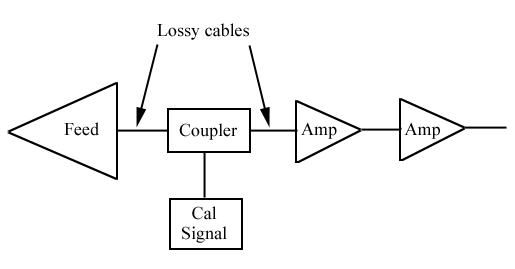 A front end that I
built for Lucent Technologies (the Solar Radio SpectroPolarimeter) is shown
in the figure below left, while the EOVSA front end is shown below right:
A front end that I
built for Lucent Technologies (the Solar Radio SpectroPolarimeter) is shown
in the figure below left, while the EOVSA front end is shown below right:
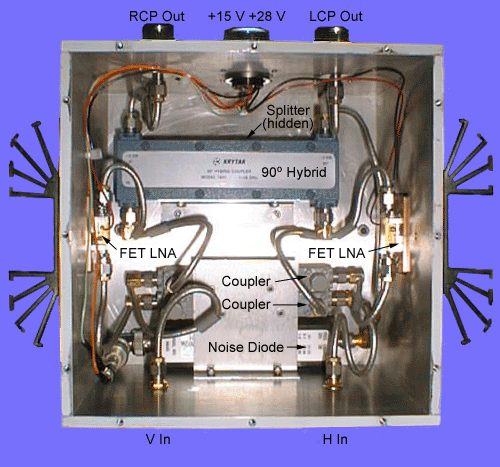
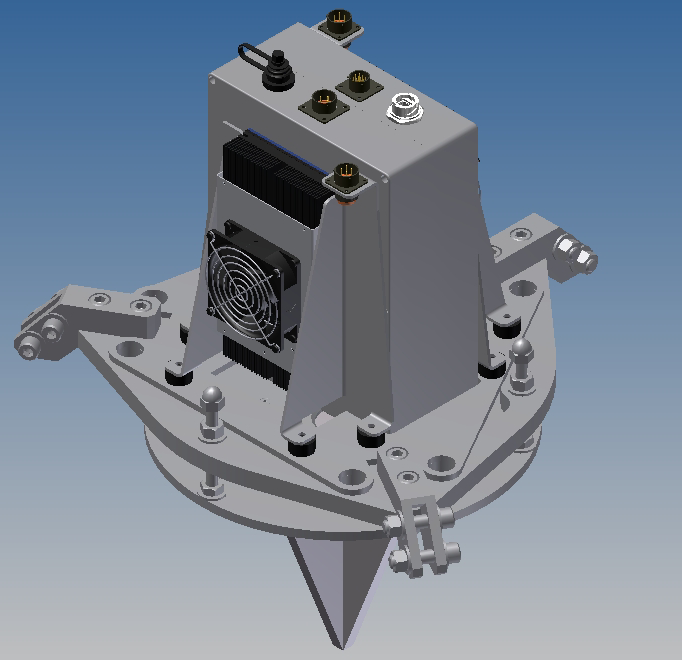
Before considering individual
elements, we develop the concept of a general 2-port device, as shown by
the rectangle in the schematic below:
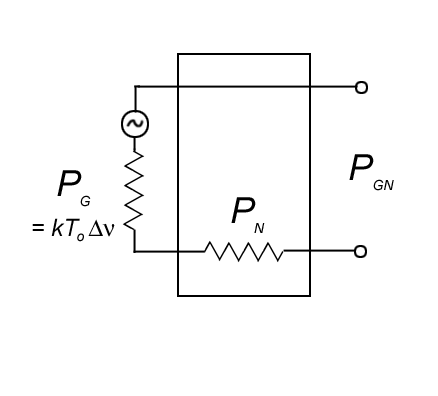 The input to this device is
some hot resistor R, which generates
noise PG = kToΔν
by virtue of its temperature To
= ambient (~290 K). The device has some internal resistance giving
added noise PN.
We can describe the gain of the device as
The input to this device is
some hot resistor R, which generates
noise PG = kToΔν
by virtue of its temperature To
= ambient (~290 K). The device has some internal resistance giving
added noise PN.
We can describe the gain of the device as
G =PGN /PG,
so that the output power is
PGN = GkToΔν.
Now replace the 2-port
device with an ideal (lossless) device and adjust the input to give an
output PN
(not PGN).
The temperature T of the external
resistor required to attain output power PN
of the original device is called the noise
temperature of the device. If the original device
has no internal noise, then PN
= 0 and T
= 0.
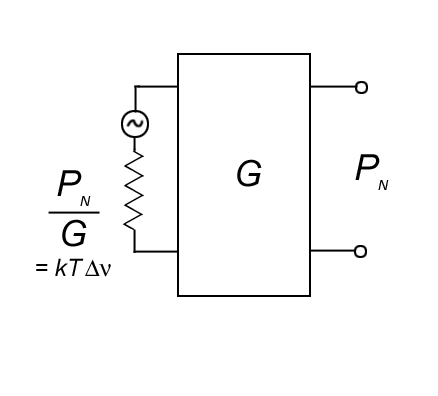 We define the noise
figure, NF, as
We define the noise
figure, NF, as
NF = (PGN
+ PN) / PGN
(= 1 if no loss)
or
NF = 1 + PN
/ PGN
= 1 + GkTΔν/ GkToΔν
= 1 + T / To
. (6)
So the noise figure is related
to noise temperature by
T = (NF − 1)
To
[To = ambient temperature,
usually considered to be 290 K]
Often, NF
is given in dB:
NFdB = 10 log
NF
Example: Miteq
LNA noise figure.
Attenuators as 2-Port
One type of 2-port device
is a "passive" attenuator. Transmission lines and cables between
components have losses, and can be considered as an attenuator. The
"gain" of an attenuator is G = ε
< 1, and associated with this gain is the
loss factor L = 1/ε.
As an example, a 3 dB attenuator
has
LdB =
3 dB => L
= 2 => ε
= 0.5.
As before, but replacing G
with ε
PGN = εkToΔν=
kToΔν/L.
The noise output of an attenuator
is
PN = (1 − ε
) kTPhysΔν,
where TPhys=
physical temperature of cable or device.
Then from (6), the noise
figure of an attenuator is
NF = 1 + PN / PGN = 1 + (1 −ε) kTPhysDn/ e kToDn= 1
+ (L - 1)TPhys / To .
But recall that the noise temperature
is
T = (NF − 1)
To
= (L − 1) TPhys
.
The meaning of this is that
a 3 dB attenuator (loss factor L = 2)
will contribute T = TPhys
to the noise temperature of the system, i.e. about 290 K, if it is put
in the front end (before the first amplifier). Thus, the attenuator
cuts the input signal by 3 dB (factor of 2), but at
the same time it also introduces 290 K of noise into the system--a
double whammy. But lossy components are sometimes used in low noise
front ends, so how to we get away with it? To see that, we have to
examine a series of 2-port devices.
Total System Temperature
of a Series of 2-Port Devices
An actual system is just
a linear chain of 2-port devices, as shown in the figure below:
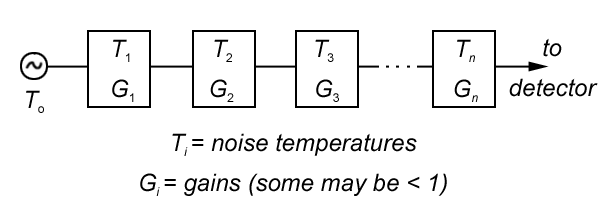 where the input (i.e. from the
feed) is shown as To, and
each two-port device is labeled with its noise temperature and gain.
Some of the gains may be less than one (i.e. a lossy cable or attenuator).
The power output of the whole system will be
where the input (i.e. from the
feed) is shown as To, and
each two-port device is labeled with its noise temperature and gain.
Some of the gains may be less than one (i.e. a lossy cable or attenuator).
The power output of the whole system will be
P = G1G2G3...GnkToΔν
+ G1G2G3...GnkT1Δν
+ G2G3...GnkT2Δν
+ G3...GnkT3Δν
+ ...
and the corresponding system
temperature is
T = To + T1
+ T2 / G1
+ T3 / G1G2
+ ... + Tn / G1G2...Gn−1
.
You can see that the external
temperature (the antenna temperature) just gets added to by all of the
noise temperatures of the following devices, but each stage after the first
stage gets divided by the total gains of the preceeding stages. This
makes the first amplifier stage all-important.
Let's apply this to a real
system, according to the block diagram below:
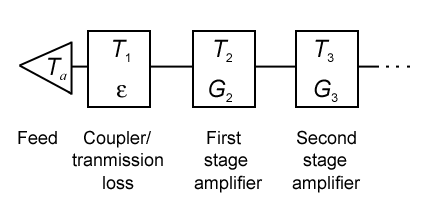 This is basically the block
diagram for the system discussed at the beginning of this section.
The total temperature of the system (from our introductory remarks above)
is
This is basically the block
diagram for the system discussed at the beginning of this section.
The total temperature of the system (from our introductory remarks above)
is
Tsys = Tbg
+ Tsky + Tspill
+ Tloss + Tcal
+ Trx ,
lump into Ta
lump into Trx
where now we can identify the
receiver temperature as
Trx = (L−
1) TPhys + LT2
+ LT3 / G2
+ ... .
To be even more specific, say
we have a system in which the cabling and coupler loss is 0.4 dB, => L
= 1.10. Further, say the noise figure
of the first amplifier is 2.5 dB =>T2
= (NF − 1)
TPhys
= (1.778 − 1) 290 K = 225 K, with
gain G2= 25 dB = 316.
Finally, say the noise figure of the second amplifier is 8 dB =>
T2
= (NF − 1)
TPhys
= (6.31 − 1) 290 K = 1539 K.
Plugging in these numbers (which are similar to the actual numbers for
OVSA):
Trx = (L−
1) TPhys + LT2
+ LT3 / G2
= (1.10 − 1) 290 K + (1.10)
225 K + (1.10)1539 K/ 316
= 29 K + 247.5 K + 5.3
K = 282 K
Notice that the noise temperature
of the first stage is all important, and as long as it has a lot of gain,
following noise temperatures are not so important. Notice also that
the loss term ahead of the first amplifier contributes to every following
stage, not just the first, so if it is not small it will dominate.
For example, there are two feeds used on the OVSA antennas, one of which
has an intrinsic loss of 3 dB, while the other has very little loss.
For homework, you will recalculate the receiver temperature using a loss
of 3.4 dB.
Note that the noise figure,
and noise temperature, are defined relative to the ambient temperature.
What if we cool the front end (the lossy parts and the first stage amplifier)
to, say, 30 K? Then the above receiver temperature would become:
Trx = (1.10
−
1) 30 K + (1.10) 23 K + (1.10)1539 K /
316
= 3 K + 25.3 K + 5.3 K
= 33.6 K
so for the greatest sensitivity
we will want to cool the receiver.
We repeat, however, that
if we are observing a bright source like the Sun, the Sun itself sets the
system temperature because the receiver temperature is small compared to
the antenna temperature. So it does no good to cool the receivers
for a solar radiotelescope, except in so far as it is needed for calibration
on cosmic sources.
To end this lecture,
let us look at what happens to the signal after it leaves the front end
and enters the receiver. The figure below is the block diagram for a downconverter module in the Expanded Owens Valley Solar Array.
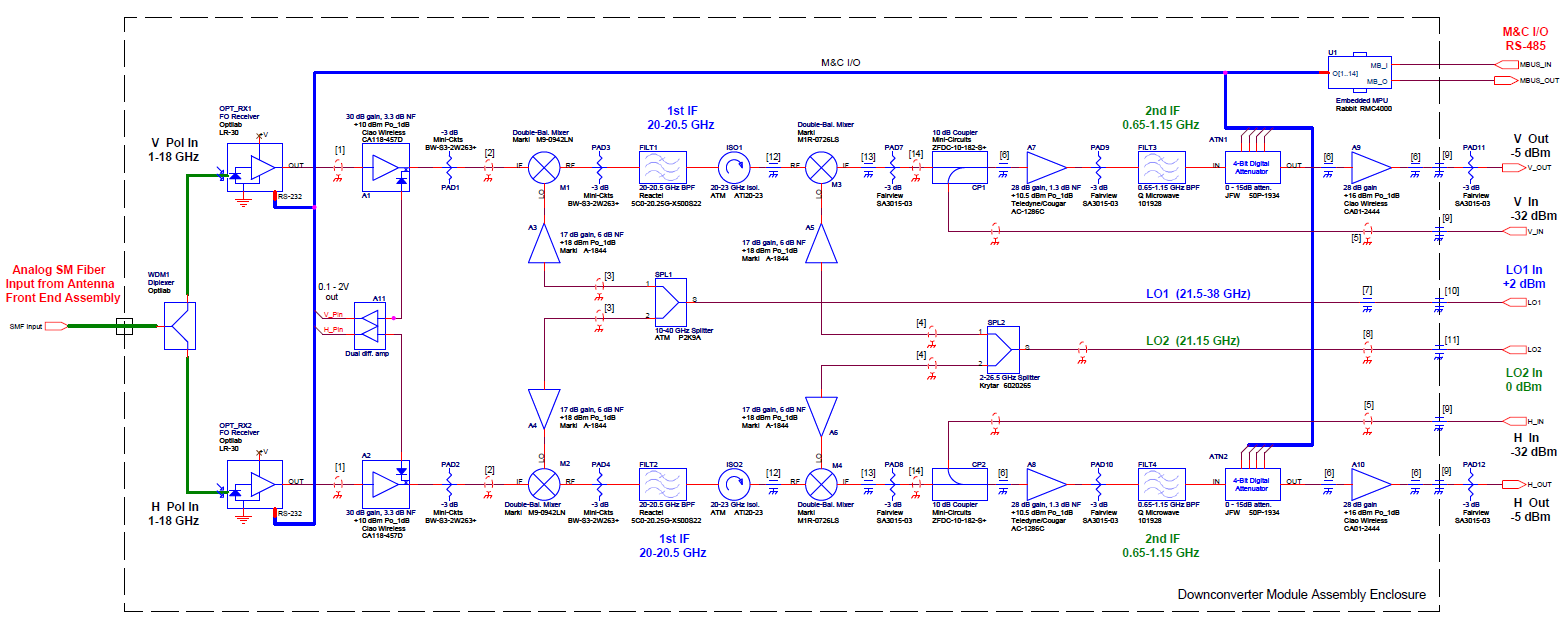
This is a dual-channel receiver,
with H pol and V pol signals being received separately on optical fiber. The signals enter
on the left and exit on the right. The signals are converted to electrical form, go through two stages of frequency conversion, which selects a 400 MHz intermediate frequency (IF) portion of the incoming 1-18 GHz radio frequency (RF), adjusts its power level by means of amplifiers and attenuators, and then provided this clean 400 MHz IF to the digitizers in the correlator chassis (not shown). We will discuss more about receivers
and following electronics when we get to correlators.






